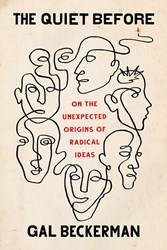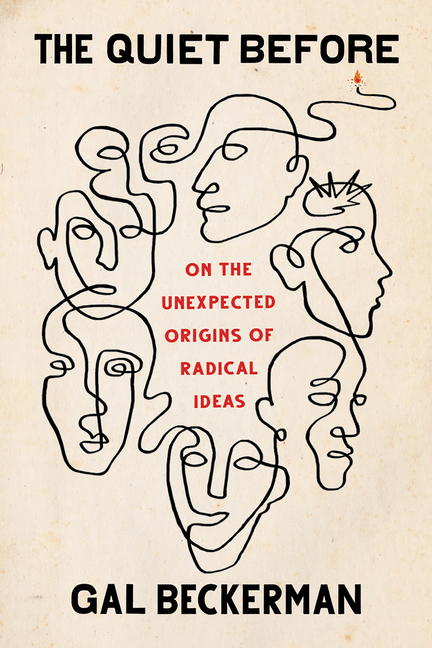The Quiet Before: On the Unexpected Origins of Radical Ideas
February 18, 2022
Gal Beckerman looks at the history of how new and unconventional ideas have spread, and if we can capture some of those elements in an online, social media world that seems devoid of quality conversation and in-depth inquiry.
 The Quiet Before: On the Unexpected Origins of Radical Ideas by Gal Beckerman, Crown
The Quiet Before: On the Unexpected Origins of Radical Ideas by Gal Beckerman, Crown
Last week, I covered a book that identified chaos in commodities markets as the main culprit for the instability that has arisen in the world over the past ten to fifteen years. But the proliferation of uprisings and protests that we have witnessed during that time—whatever their cause, and to whatever ends—have been organized and disseminated on social media, and there is a lot to explore in that phenomena, as well. How the businesses that dominate that online space have altered the way we live, connect to, and converswe with one another—and even their efficacy is protest movements—is well covered territory. Gal Beckerman, in his new book The Quiet Before, brings a new dimension to it by looking at the ways in which new and unconventional ideas—ones that have upended or altered our understanding of the world—have gained traction in the past.
From the Republic of Letters—the robust correspondence that took place among European intellectuals and proto-scientists in the 1600s—to the petitions for universal suffrage in United Kingdom in 1800s, from the sparks of African independence in community newspapers in the early part of the 20th century to the Samizdat passed along on onionskin in the Soviet Union, ideas that affect change have taken hold in the same way Mike Campbell went bankrupt in Ernest Hemingway’s The Sun Also Rises, in “Two ways,” actually, “Gradually, then suddenly.” The ideas and information spread in these movements were incubated and spread in smaller circles, experimented with and improved upon, before they were then gradually embraced on a larger scale. In our era of instant gratification and always-on media, we may think the rules have changed, but ignoring such lessons and examples about how ideas spread comes at the cost of our own ability to influence events outside of social media. As Beckerman writes:
Even though we now raise an eyebrow when the Silicon Valley titans say their platforms exist to “change the world,” we’ve stopped thinking of any other means through which the world can be changed. The platforms dominate.
The platforms have, in fact, changed the world. Just not in the way in which they were marketed to us. Rather than focus our energies, the large social media platforms bury them in a cacophony. Beckerman offers an apt analogy:
They are social in the way a loud cocktail party is, where you flit from conversation to conversation, drawn for a few minutes to someone’s crazy story or funny joke, but leave drained by the end of the evening. These are spaces built, first, to make a profit. About this, we are no longer naive.
He begins his exploration of alternatives with Nicolas-Claude Fabri de Peiresc, who in 1635 planned the simultaneous observations of a lunar eclipse that helped establish the longitude of various places in Eurasia and establish the first accurate measurements of the Mediterranean Sea. He was able to pull off such a feat because he was “a leading citizen of the self-proclaimed Republic of Letters, the network of dozens and dozens of university scholars, learned aristocrats, and clergy spread throughout Europe.”
Together, they were exploring the era’s newfound mysteries—astronomical, microscopic, and geographic.
This was a dangerous activity at the time. Giordano Bruno was burned alive at the stake for suggesting the Earth was not the center of the universe, and Galileo’s writings on the topic were famously denounced and banned, putting him under house arrest. Peiresc chose “the hushed, discursive conversation of the letter versus the loud declaration of the book.” He had correspondence with people as far afield as Quebec and Syria taking down observations the night of the eclipse, and it wasn’t a task that could have been as easily accomplished before then. The recent development of a reliable post to exchange letters and regular correspondence is what allowed such collaboration. Unlike the instantaneous, hyperactive, and often combative social media feeds of today, Beckerman explains how the slowness and pleasantries involved in the medium “didn’t demand definitiveness yet gave space for argument to ‘build lightly.’” It held room for nuance and a more thoughtful debate of ideas:
But they also worked well for introducing a new worldview. The ruminative aspect of letters, the embedded patience of them, avoided what might otherwise feel like a locked horn confrontation of one system of truth trying to overtake another.
In the ten historical vignettes he brings to bear on how radical ideas take shape and take hold (or not) from Peiresc to the Black Lives Matter protests, it is that focus on new and sometimes competing worldviews that holds constant. But the book has its ups and downs, not in the quality of the writing which remains impeccable, but in the feelings it elicits in the reader. The chapter on the manifestos of Italian Futurists is, frankly, terrifying, though he does find a protagonist in the midst of it that we can root for. A chapter exploring the chat rooms that led to the “Unite the Right” rally in Charlottesville that left Heather Heyer dead is equally dark and disturbing. Even in his search for digital alternatives to the digital behemoths that gobble up so much of the air online, many of the examples he found of people engaging in smaller, more secretive groups were, in his own words, “horrifying.” And many of the chapters that end on a hopeful note, such as the one on Nnamdi Azikiwe’s African Morning Post, with its exhilarating example of community driven discourse and eventual independence, are somewhat negated by the historical developments that followed (and which he touches upon in the book’s Epilogue).
If there is a call to a action at the end of it all, it is that we need to keep conversing with and connecting to one other, and that we need to find new places to do so on a deeper level than the largest platforms allow. The book’s conclusion, in that way, may seem somewhat inconclusive, and I think rightly so. Seeing the scientific progress that occurred during the Republic of Letters juxtaposed with the anti-scientific disinformation that occurred online during the pandemic, we understand that history and progress is not linear. Understanding how the alt-right being deplatformed led them into more private spaces online that ultimately increased their chances at cohesion and more effective community building is frightening, but also informative. It reminds us that the tools are not the problem, and that they can be used for multiple purposes and ends (Discord, where they gathered, was a platform designed for gamers to chat with each other). It reminds us that formulating ideas and a more effective means for communicating them involves going beyond the quick hits of information we get or share in the usual spaces online, and that we need to dive deeper into ideas and the information floating around and find spaces outside of the usual cacophony to discuss it. Those spaces are often perceived as dark and dangerous, and they can be and often are, but they don’t have to be. In fact, “chat apps like WhatsApp, Discord, iMessage, Snapchat, Slack, Telegram, and Signal” now have “some of the exact qualities that made the pre-digital forms of interactive media so usesful.” Ethan Zuckerman, who worked on a project to “map the full breadth of social media” outside of the major platforms as a visiting research scholar at the Knight First Amendment Institute, defines those as “privacy, ephemerality, and community governance.”
They can be spaces where we don't need to be concerned with the more public and performative aspects of everything we share, where we can be more contemplative and not afraid to say something wrong as we work things out. As Phillip Agnew, co-founder of Dream Defenders, a group with the admittedly radical (and I'm sure terrifying to some people) mission of "fighting for a world without prisons, policing, surveillance and punishment,” put it:
“We must re-embrace the great strategic value in everyone not knowing everything we do, when we do it, and whom we do it with.”
It can be, and was, as simple as a private email chain. The penultimate chapter of the book looks at one such email chain started between scientists and public health officials in the early days of the COVID-19 pandemic. It was a thread that brought experts together to model and monitor the early progress of the disease, but eventually morphed into a discussion of how they could disseminate accurate information into an environment where disinformation and confusion seemed to spread as rapidly as the disease itself. It was a forum which, “in addition to making them more productive, allowed them to feel as though they weren’t alone in their total commitment to science.”
The email chain provided the conditions for this feeling, for this work, in much the same way the Chronicle had allowed Soviet dissidents to document human rights abuses that would never be redressed.
Different forms of media rise and fall, change and evolve. Radio was once seen as stodgy and old, and is now new again in the form of podcasts. NPR has provided a different, non-commercial model that seemed unlikely to stick when it launched 50 years ago and is now a staple in communities across the country, and right-wing talk radio remains extremely influential. I don’t think most of us would have envisioned 10 years ago that television would rival the silver screen in innovation and the scope of its storytelling abilities. And so I don’t think any of us know how social media platforms will evolve. It has been looking grim for many years now, but Gal Beckerman has convinced me that we may all still have a bigger part to play, and that the hope for such platforms has not entirely died.
But, to be honest, I would have enjoyed the book even if it didn’t offer that glimmer of hope. I was hooked early in the book by the history it relates and the quality of the writing. It is complicated and nuanced, and doesn’t offer easy answers, but it sure was easy to read. I was never sure where or how it would end up, but I was along for the ride, and even in its dark moments, I found it hard to put down. I'm sure you will, too.



